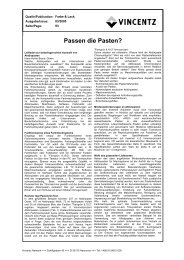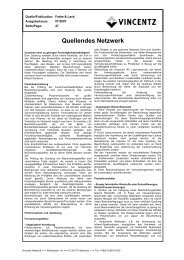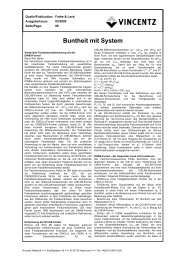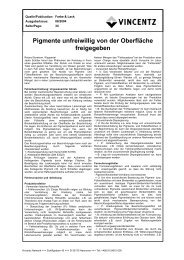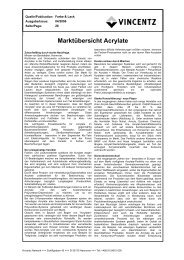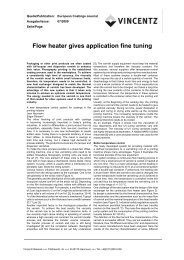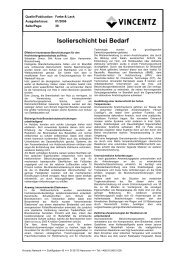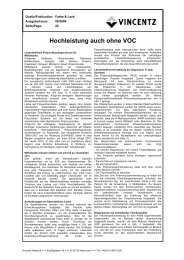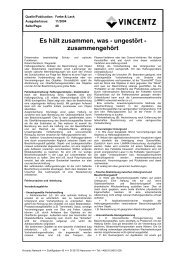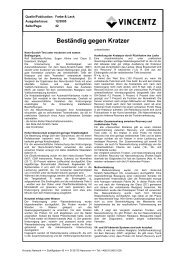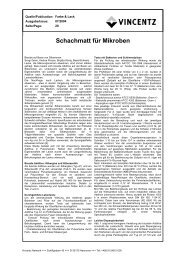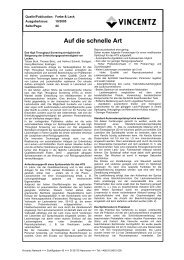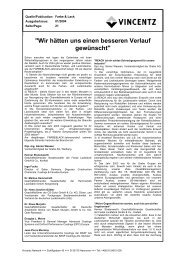Applause for ECS 2003 - European-coatings.com
Applause for ECS 2003 - European-coatings.com
Applause for ECS 2003 - European-coatings.com
You also want an ePaper? Increase the reach of your titles
YUMPU automatically turns print PDFs into web optimized ePapers that Google loves.
Quelle/Publication: <strong>European</strong> Coatings Journal<br />
Ausgabe/Issue: 05/<strong>2003</strong><br />
Seite/Page: 20<br />
Premiere with simultaneous translation<br />
During the one-day 4th Construction Chemicals Congress<br />
on April 10th, 12 select lectures dealt with current scientific<br />
and technical developments as well as topics of interest<br />
from within the sector. Simultaneous interpreting was<br />
provided <strong>for</strong> the first time and attracted a large contingent of<br />
delegates from <strong>for</strong>eign countries.<br />
Rainer Sobek, vice-president of German Bauchemie e.V.,<br />
opened the congress in confident tones, drawing attention to<br />
the high importance of the construction chemicals, including<br />
its social dimension: "Important buildings throughout the<br />
world cannot be - and could not have been - built without the<br />
use of construction chemical products". But he also<br />
addressed the problems besetting the construction<br />
chemicals sector, especially in Germany: "The weakness in<br />
the German construction sector is now in its 5th year - we<br />
do not feel like celebrating". But it is precisely in difficult<br />
times that there is a great need to exchange in<strong>for</strong>mation and<br />
knowledge - this too was revealed by the 4th Construction<br />
Chemicals Congress.<br />
2nd Ink Makers' Forum<br />
All about inks<br />
The printing inks market is currently going through hard<br />
times, but this is actually <strong>for</strong>cing a certain amount of<br />
differentiation on the ink manufacturers - the thing to do now<br />
is to stand out from the market not only in cost but also in<br />
technological leadership. During the <strong>ECS</strong>, the Ink Makers'<br />
Forum, 2nd <strong>European</strong> Congress on Printing Inks, provided<br />
an opportunity to hear about technical details from<br />
international experts on current innovations in the fields of<br />
binders, pigments and colorants, additives <strong>for</strong> printing ink<br />
<strong>for</strong>mulations as well as on new production and testing<br />
technology.<br />
The 70 delegates from 14 countries heard 23 expert lectures<br />
- spread <strong>for</strong> the first time over two days - that reflected the<br />
full range of current developments in printing inks, and also<br />
discussed the current market and legislative situation.<br />
In the opening session, Martin Kanert (VDMi/CEPE),<br />
especially, caused a stir when he explained the impact that<br />
the planned EU chemicals policy - to the extent it is known -<br />
would have on the printing inks industry, and he then<br />
<strong>for</strong>mulated CEPE's position on this. An important point of his<br />
deliberations: according to estimates, the costs of chemical<br />
registration as provided <strong>for</strong> under the REACH program<br />
would increase the cost of substances produced in<br />
quantities of less than 1 t/a by around 42% (this figure being<br />
<strong>com</strong>mensurately lower <strong>for</strong> larger amounts): 10 t/a: 11%, 100<br />
t/a: 5%, 1000 t/a: 2%, 10,000 t/a: 0.4%). Of course,<br />
additives will be mostly affected by this. The probable<br />
consequence would be the disappearance of a large<br />
number of chemicals from the market. The German VCI<br />
estimates that this will be the case <strong>for</strong> 20 to 40% of<br />
substances produced in quantities ranging from 1 to 100 t/a.<br />
Some highlights from the technical sessions<br />
The migration of unreacted photoinitiators and their<br />
breakdown products from UV cured inks is of increasing<br />
concern in the food packaging industry. R. Stephen<br />
Davidson presented on behalf of Coates Lorilleux new<br />
multifunctional photoinitiators (MFPI's) that have been<br />
developed to reduce the amounts of extractable<br />
<strong>com</strong>ponents in UV-cured coating. Because of their<br />
multifunctionality, the photoinitiators are firmly embedded<br />
within the binder during cure, while still keeping a good<br />
reactivity to achieve full cure of the system.<br />
The "dynamic fingerprint" of any ink <strong>for</strong>mulation can be<br />
generated with a time-dependent differential maximum<br />
bubble pressure technique. As Victor P. Janule (ChemDyne)<br />
explained, this allows <strong>for</strong>mulators to characterize the ink<br />
per<strong>for</strong>mance under all possible process conditions be<strong>for</strong>e<br />
the ink is used. This is especially important when multiple<br />
surfactants are present in the <strong>for</strong>mulation. As the<br />
measurements show, the <strong>for</strong>mulations that give the lowest<br />
surface tension may not be the best.<br />
Wim Peter Stout (Air Products) talked about how important it<br />
is to adjust and control surface tension in printing inks.<br />
Acetylenic diols are well known as high per<strong>for</strong>ming additives<br />
<strong>for</strong> the waterborne liquid inks, showing the technical<br />
advantages offered by Gemini surfactants. Stout presented<br />
a new generation of these additives, which offer even better<br />
per<strong>for</strong>mance benefits.<br />
Jörg Seubert (Eckart Werke) presented new aluminium<br />
metal pigments that can be produced as very thin platelets<br />
of highly uni<strong>for</strong>m thickness by means of PVD (physical<br />
vapour deposition). These pigments exhibit pronounced<br />
non-leafing behaviour and the binder protects them very well<br />
in printing inks against mechanical and chemical influences.<br />
They are ideal <strong>for</strong> mirror-effect inks. They are not meant to<br />
<strong>com</strong>pete against conventional metal effect printing inks, but<br />
rather to replace metallising layers, e.g. in packaging and<br />
labels. The advantage of these mirror-effect inks is that they<br />
can be applied precisely and exclusively to the areas where<br />
they are used in the decoration - this is not possible with<br />
metallisation.<br />
Masterbatch Day: Small but distinguished<br />
Some 28 international masterbatch manufacturers gathered<br />
at the <strong>ECS</strong> in a relaxed atmosphere <strong>for</strong> their first joint <strong>for</strong>um:<br />
Masterbatch Day. A series of five short lectures gave them<br />
an insight into pigments (white, carbon black and effect<br />
pigments), waxes and especially <strong>European</strong> legislation,<br />
which is of vital concern to them as masterbatch<br />
<strong>for</strong>mulators. The various directives, guidelines and<br />
ordinances addressed were those on preparations, material<br />
safety data sheets, hazardous goods, toys, packaging and<br />
waste, and materials and articles intended <strong>for</strong> food contact.<br />
Substantial breaks during the day ensured there was plenty<br />
of time to get to know each other and to trade expertise.<br />
East & West: Connecting Europe<br />
Neighbours mingling<br />
Up until now a "mere" <strong>for</strong>um, the <strong>European</strong> <strong>coatings</strong><br />
convention "East & West: Connecting Europe" was<br />
expanded this year to include a lecture series. The lectures<br />
delivered by the leading paint managers from Western,<br />
Central and Eastern Europe were received with great<br />
interest. An audience of 120 used the chance on April 9th to<br />
find out about the various national markets, to hear statistics<br />
and to catch up on local trends. Where else is there an<br />
opportunity to get firsthand basic data on, <strong>for</strong> example, the<br />
Estonian <strong>coatings</strong> market? As David O'Brock of Viru Keemia<br />
Grupp explained, some 14,400 metric tonnes of paints and<br />
surface <strong>coatings</strong> were produced there in 2001, with 36% of<br />
the market held by non-Estonian <strong>com</strong>panies. The various<br />
speakers demonstrated the potential af<strong>for</strong>ded by the various<br />
East <strong>European</strong> <strong>coatings</strong> markets with the aid of market<br />
analyses and surveys. The atmosphere remained intimate<br />
and in<strong>for</strong>mal throughout; contact between east and west<br />
smoothly transcended whatever linguistic borders there<br />
might have been. This <strong>coatings</strong> event has now developed<br />
into a valuable in<strong>for</strong>mation and contact mart. Simultaneous<br />
interpreting was provided <strong>for</strong> the two Russian lectures. The<br />
remaining contributions were delivered in English.<br />
Workshop Production Technology<br />
Vincentz Network +++ Schiffgraben 43 +++ D-30175 Hannover +++ Tel.:+49(511)9910-000



